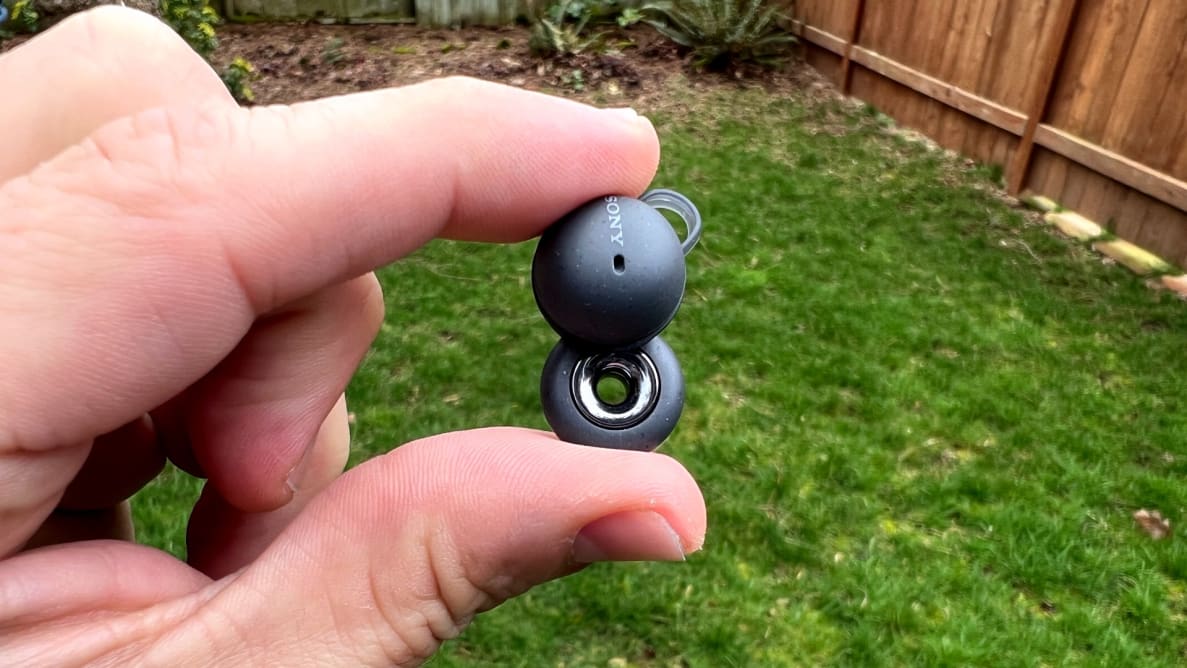Pros
-
Natural audio awareness
-
Good sound and features
-
Slick, micro design
Cons
-
Mediocre battery life
-
Narrow use cases
-
Face-tap controls are limiting
Editor's Note (October 25, 2022): Sony has announced that they are adding multipoint Bluetooth pairing to the Linkbuds with a firmware update in November 2022.
The vast majority of earbuds at this price provide a much more versatile sound palette than the Linkbuds. For $180 (or less) you’ll usually get transparency mode and active noise canceling (ANC), letting you turn up or tune out the din of life at your leisure via exterior microphones and digital processing. It’s a less natural solution than open drivers, and it comes with trade-offs like poor performance in gusty weather or wind shear. That gives the Linkbuds a solid niche to occupy for those intrigued by the idea of aural awareness anywhere.
But as you might guess, there are plenty of situations in which the Linkbuds aren’t great; from the clanking barrage of a bustling city sidewalk to the buzz of an airplane engine or the wine of a subway car, the Linkbuds’ open-door policy lets all parties through, no matter how displeasing. And that’s not their only innovation that takes adjustment—their face-tap controls are both odd and, in my experience, less accurate than traditional controls. That said, if you want earbuds that let the world in, naturally and without distinction, the Linkbuds are worth consideration.
About the Sony Linkbuds (WF-L900)
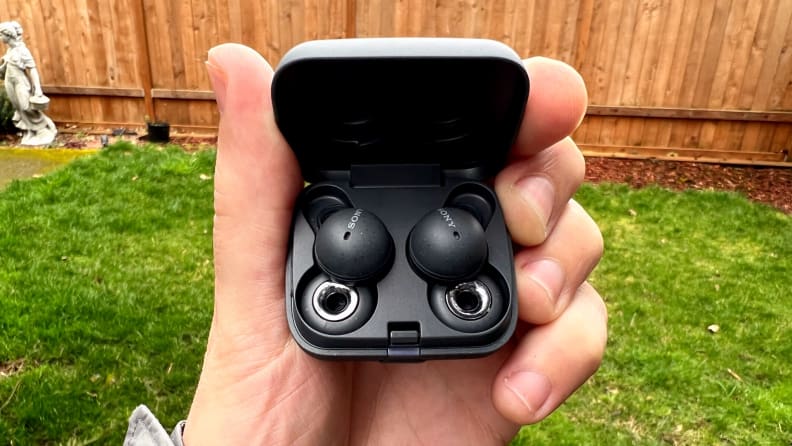
The Sony Linkbuds look unlike anything you'll find in the category thanks to their silver holes at the bottom.
Here are the Linkbuds’ basic specs:
- Price: $179.99
- Battery life: Up to 5.5 hours, 17.5 hours with charging case
- Fast charging: 10 minutes of charging for 90 minutes of playback
- Colors: Gray, White
- Ambient sound modes: none (open-ear design)
- Sound: proprietary ring drivers, Sony V1 processor
- Connectivity: Bluetooth 5.2
- Audio codecs: SBC, AAC, Sony DSEE audio enhancement
- Dust/water resistance: IPX4
- Fit: Four ear loop sizes (ear tip free)
- Weight: ~4 grams per bud, 34 grams charging case
- Special features: Open-ear awareness, Speak-to-chat, Adaptive volume, 360 Reality Audio, Alexa/Google Assistant/Siri control, Google Fast Pair*, Spotify Tap Playback* (*requires Android 6.0 or higher)
The Linkbuds arrive in a minimalist cardboard box that’s “plastic free” for sustainability and as small as we’ve come to expect in the micro-machine world of fully wireless earbuds. Inside you’ll find an equally tiny case that harbors the oblong buds with, as promised, an odd little silver hole bored through the bottom of each. Accessories include a tiny USB charging cable and four little wing loops in place of ear tips to keep the buds secure in your ears.
What we like
A unique, miniaturized design
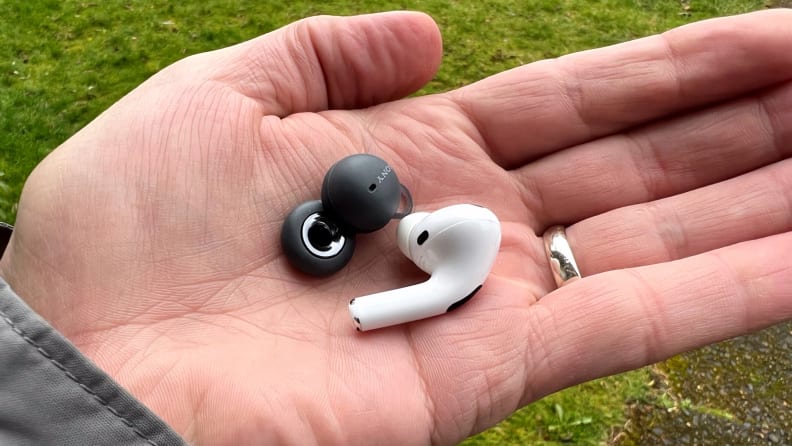
The Linkbuds are both smaller and lighter than AirPods.
Whatever your thoughts on the Linkbuds, you won’t have any trouble hauling them around. The included charging case is a bit thicker than the ultra-thin AirPods Pro and AirPods 3 cases, but otherwise its dimensions run smaller than any case in my sprawling arsenal. A button set above a charge-status LED in front unlocks its clamshell hinge, revealing the double-loop earbuds within.
Again using the AirPods Pro for comparison, the Linkbuds are similarly sized and, at just 4 grams, around 20% lighter. That’s a lot easier to accomplish when you don’t include any noise cancellation tech inside, but still a feat to admire in the age of ever-shrinking devices. The donut drivers at the bottom are unlike any I’ve encountered and, while the buds look a little odd in your hand, they shrink in your ears so only the bulbous topside peeks out. All-in-all it’s a slick package.
Awareness in any setting
Of course, the best reason to get the Linkbuds is that you want that sweet, sweet sound of the whole wide world to cradle your ears wherever you go and whatever you listen to, and the Linkbuds are up to the task. Whether you're on the job, talking to your SO on a snack break, or hitting the pavement for your daily jog, the Linkbuds keep you aurally aware.
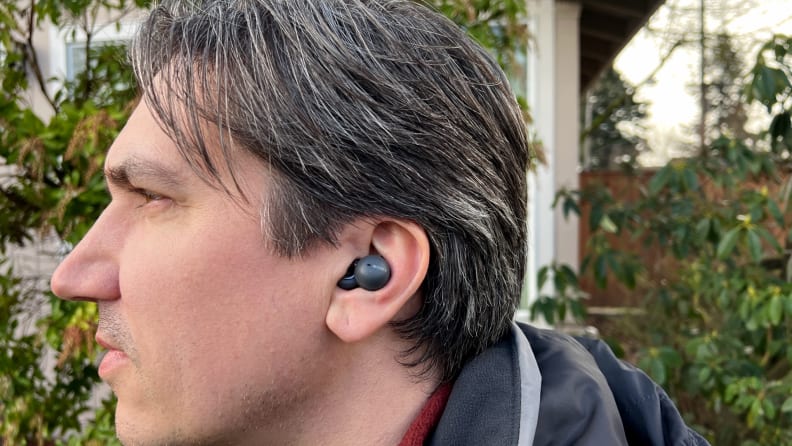
The small hole at the bottom lets sound filter through directly to your eardrum.
Sony proposes other use cases, too: teens who want to keep one ear in the real world and one in the virtual can now marry them together; work-from-home staffers who’d prefer keeping their ears ready for crying kids rather than shutting them out; yoga students who want to jam their own tunes to the teacher’s instructions. None of these instances really apply to me—and I’m generally fine using transparency mode or a single earbud in cases that do—but that’s the Linkbuds idea and it works.
Another good use case is bike riding, where the wind of the road will blow out even the most optimized microphones for earbuds in transparency mode. The Linkbuds worked quite well in this scenario, though I did note that their spherical tops create their own fair share of wind noise, making the experience less seamless than other open-ear solutions on the rise like Bose’s audio sunglasses, the Frames.
Surprisingly clear sound and calls
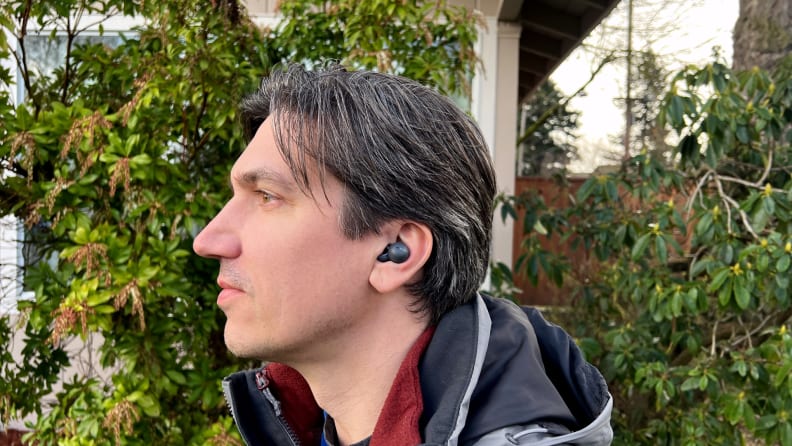
While bass isn't thunderous, the sound is surprisingly clear and full for an open ear solution, with equally clear phone calls.
In reference to the audio sunglasses example above, while Bose’s Frames sound incredibly good for speakers that must beam the sound down to your ears, the Linkbuds have them beat on sound performance, especially in the bass department. It's not skull rattling by any means, but it's fully represented. Going further, the Linkbuds sound better than virtually any similar open-ear device I’ve tried, including bone conduction earphones. Offering clear, balanced, and full sound that lingers on the details, the Linkbuds sound similar to or better than a lot of true wireless earbuds without holes.
Credit Sony’s engineering for those circular drivers, which focus the sound from their dish-design like a Death Star laser shot to your ears—as long as you’ve got them properly adjusted. There’s a tautness to the sound that is all Sony, pushing forth the crisp snap of percussion, the subtle affectations of vocals and string work, and the smooth punch of bass instruments and synthesizers.
Calling, too, was extremely clear and present in the calls I made, though unlike fully enclosed earbuds, wind gusts may be of particular note with these buds from the user side. Otherwise, they offer excellent performance on either end of the call.
The musical performance isn’t nearly as intimate or powerful as what you’ll get from premium noise-canceling buds like Sony’s own WF-1000XM4 or Jabra’s Elite 85t, and even Samsung’s cheaper Galaxy Buds 2 have an edge in overall detail and punch. There’s only so much you can do with a soundstage that’s mingled with the aural world around you, and that waters down the mix to some degree.
But rest assured, these buds carry the Sony brand in more than name only.
Plenty of features and settings
Sony has laden the Linkbuds with a relatively full suite of options, with a few notable exceptions. You’ll get decent (not amazing) IPX4 waterproofing, adjustable settings like Auto-pause when you pull a bud out, a multi-band EQ to tailor the sound to your taste, a setup function for Sony's 360 Reality Audio tracks, and modern extras like Spotify Tap and Google Fast Pair with compatible devices. They also offer Sony’s DSEE audio engine for upscaling compressed audio.
Sony’s fantastic Headphone app unlocks the majority of these options, and there are also a few Sony extras thrown in there, some of which will be more useful than others depending on preference. Sony’s Speak to Chat feature, for instance, is a cool concept designed to pause audio for up to 15 seconds when you speak. But even at the lower setting, I find it too sensitive, often pausing audio when I clear my throat. It also reminds me of how often I talk to my pets during the workday which is maybe best left unnoticed.
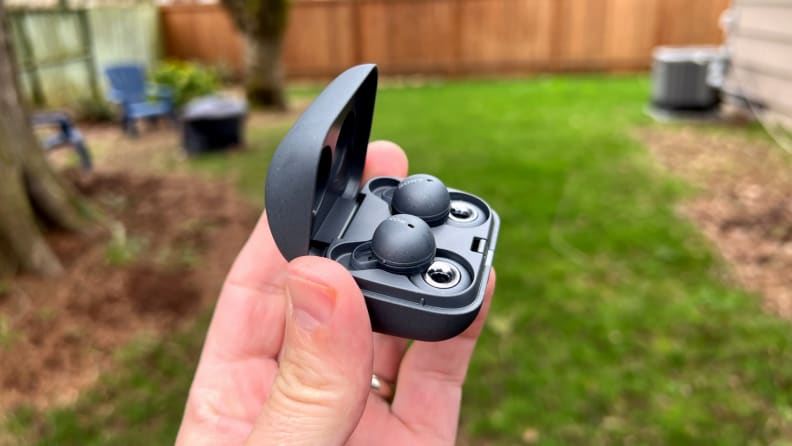
There are plenty of features here, though I found some of the extras more useful than others.
Similarly, the Adaptive Audio option is an intriguing one, if counter to the concept of environmental awareness, designed to ramp up the volume of your music or podcast when the exterior world gets loud. Unlike Google’s Pixel Buds version, it works quite well—too well for me in some cases. There was far too much volume difference between stopping and starting when I was riding my bike, for instance. And again, it kind of takes away from the whole open-ear concept, but it could serve as a counter in sudden situations where things get too loud.
There are some missing features I would have liked to see in the package like a wireless charging case (you’ll need to plug in) and multipoint pairing to connect to two devices at once. Since Sony obviously didn’t have to pony up for noise canceling or transparency mode, those would have been nice extras. Still, there’s plenty here to keep users satisfied, including some futuristic options.
What we don’t like
The face-tap controls are odd (and sometimes inaccurate)
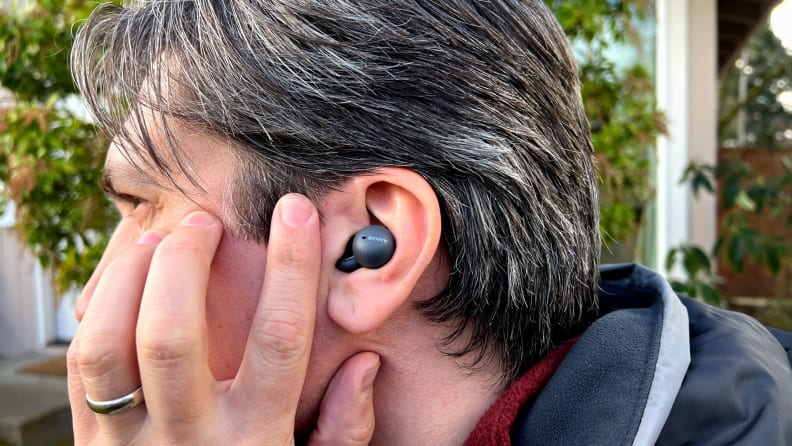
Tapping your cheek is an intriguing way to control the buds but it's a limited solution that didn't always work for me.
One of the Linkbuds’ most intriguing innovations is also the one I like the least. The buds are designed to allow you to double or triple tap not only the buds themselves but also your own cheek to control parameters like volume, voice assistants, and basic playback. Besides the weirdness of looking like (as my wife put it) someone signaling to leave a party, tapping your face for control is both limiting and, in my experience, less accurate than traditional options.
It’s likely that Sony created this to solve a problem: the only surface to orient (and reorient) the buds in your ears is also the one that you’ll tap for controls. As such, the surface was made to be less sensitive than most earbuds, and liable to misfire. The face tap controls use a sensor as a workaround that’s innovative and effective—until it’s not. It seemed every time I deliberately tested the controls, they’d work, but at random times when I was preoccupied, I’d find a double-tap did nothing but betray a potential nervous tick. Again, it usually works, but I counted over a dozen misfires.
In addition, offering only double and triple taps means you have about half the options of buds with traditional touch pads or buttons that let you single tap or hold for more controls. You can swap what the Lindbuds’ tapping options do in the app (I went for volume on the left and playback on the right), but you’ll never have all controls at once.
Next-gen design, last-gen battery
The Linkbuds claim 5.5 hours of battery, which seemed about right in my testing, if not conservative. It’s enough for most use cases, but it’s less than we expect from buds in 2022 that don’t have to overcome the power drain of active noise canceling. Still, the Linkbuds are so light, it’s understandable that they have a lightweight battery.
What’s less understandable is a charging case that only offers an extra 12 hours of top-off. Nearly any name brand earbuds at this price (or below) will get you more. The simple result is you can’t go as long or as far with the Linkbuds before you need to plug in, and that gap will only grow with time.
Some minor comfort and durability concerns

Inserting the buds has a learning curve and the rigid plastic isn't as comfortable for me long term as some of my favorite earbuds.
The Linkbuds are comfortable enough for a few hours, though their rigid, eartip-free design tends to wear on my ears more than my favorites over time. That’s partially because almost all of the fit is based around the plastic shells, save for the tiny loop at the top which is a bit awkward to put in and, for me, has a tendency to slip out at times. You also have to be careful about the driver orientation—a subtle movement in your ear can greatly affect sound quality.
All ears are different, so all of this may affect yours less, and the four different loop sizes could be the right solution for comfort. On that note, though, the little loops are thinly threaded, which raises some questions about how long they’ll last in the long term.
Innovation is a double-edged sword
As noted at the intro, their inherent design simply limits the use cases for the Linkbuds. While it’s unfair to attack a product for working as intended, versatility is important. Could they work as your everything earbuds? Maybe, but they won’t be ideal for everything you do. If you have enough money to buy multiple earbuds for multiple scenarios this may not matter, but if you want one pair to rule all, the Linkbuds come up short when the world gets loud.
Should you buy them?
Maybe, if you want to let the world in (no matter what)

The Linkbuds are extremely light and small, designed to fully insert in your ears.
Sony’s new Linkbuds offer innovative design, surprisingly good sound and calling performance, and enough features to justify their price point even without coveted options they inherently dismiss, like active noise canceling. Their design does exactly what it sets out to do, and they sound as good or better than any open-ear sound solutions I’ve tried. But, of course, there’s a downside to always-on external audio.
If you don’t have money to spend on bifurcated use cases for your earbuds, you can get into all kinds of great earbuds options that let you use either one bud at a time or transparency mode at the press of a button for a blast of the outside world. Jabra’s Elite 4 Active are great all-rounders at a considerably lower price point, and include both transparency mode and decent active noise canceling in a fully waterproof design. Samsung’s Galaxy Buds 2 are another solid option for less, though they’re not nearly as sport-ready as Jabra’s option.
And, of course, Apple’s AirPods Pro are a perennial favorite for iPhone users. Their semi-open fit also lets you turn on or off the outside world effectively, with among the most natural-sounding transparency modes around. They’re pricier, but their sale price is often in line with the Linkbuds. Finally, for even more ear freedom, Bose’s Frames are a cool solution, but they’re much less versatile than the Linkbuds, and don’t sound quite as full either.
Sony’s Linkbuds are nothing if not unique. If you love the idea of letting in the world around you, no matter what, they’re among the best options out there.
Meet the tester
Hailing originally from Montana, Ryan parlayed his time working as a musician and audio engineer into a career in digital media in 2012. Since then he's had extensive experience as a writer and editor, including everything from op-eds and features to reviews on TVs, audio gear, smart home devices, and more.
Checking our work.
Our team is here to help you buy the best stuff and love what you own. Our writers, editors, and experts obsess over the products we cover to make sure you're confident and satisfied. Have a different opinion about something we recommend? Email us and we'll compare notes.
Shoot us an email